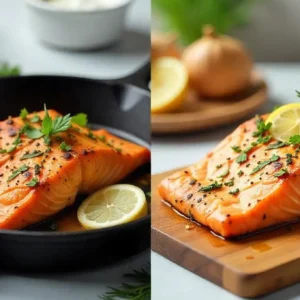
Is It Better to Pan Fry or Oven Cook Salmon?
Pan-frying and oven-baking are two of the most popular ways to cook salmon, but each method offers unique advantages. Pan-fried salmon delivers a crispy, caramelized crust and cooks in under 10 minutes. Oven-baked salmon is more hands-off, keeps the fish tender and juicy, and is ideal for batch cooking.
Equipment
- 1 Non-stick or cast-iron skillet For pan-frying salmon
- 1 Baking Sheet For oven-baking salmon
- 1 Aluminum foil or parchment paper To retain moisture when baking
- 1 Spatula For flipping salmon
- 1 Instant-read thermometer To check salmon doneness
Ingredients
For Pan-Fried Salmon
- Amount Unit Ingredient Notes
- 4 fillets Salmon skin-on preferred Fresh, wild-caught recommended
- 2 tbsp Olive oil or butter For searing
- ½ tsp Salt Adjust to taste
- ½ tsp Black pepper Freshly ground
- 2 cloves Garlic Optional for flavor
For Oven-Baked Salmon
- Amount Unit Ingredient Notes
- 4 fillets Salmon Can be skinless or skin-on
- 1 tbsp Olive oil For brushing
- ½ tsp Salt Adjust to taste
- ½ tsp Black pepper Freshly ground
- 1 whole Lemon Sliced for extra flavor
- 1 tbsp Fresh herbs dill, parsley Optional for garnish
Instructions
Option 1: Pan-Frying Salmon for a Crispy Finish
- Heat the pan: Place a non-stick or cast-iron skillet over medium-high heat and add 2 tbsp of oil.
- Prepare the salmon: Pat the fillets dry with a paper towel. Season both sides with salt and black pepper.
- Sear the salmon: Place the salmon skin-side down in the pan. Cook undisturbed for 4–5 minutes until the skin is crispy.
- Flip and finish cooking: Carefully flip the fillet and cook for another 2–3 minutes until the salmon reaches an internal temperature of 125-130°F (52-54°C) for medium-rare.
- Optional flavor boost: Add minced garlic and a squeeze of lemon juice during the last minute for extra depth.
- Rest before serving: Remove from the pan and let the salmon rest for 2 minutes before plating.
Option 2: Oven-Baking Salmon for Tender, Juicy Results
- Preheat the oven: Set to 375°F (190°C) and line a baking sheet with parchment paper or foil.
- Season the fillets: Place the salmon on the sheet, brush lightly with olive oil, and sprinkle with salt, pepper, and lemon slices.
- Wrap for moisture: If you prefer extra moisture, loosely tent foil over the salmon to trap steam.
- Bake: Transfer the baking sheet to the oven and cook for 12–15 minutes or until the salmon reaches 145°F (63°C).
- Optional crispy finish: For a golden-brown top, remove the foil and broil for 2 minutes at the end.
- Garnish and serve: Sprinkle with fresh herbs and serve immediately.
Nutrition Facts (Per Serving)
- Nutrient Pan-Fried Salmon Oven-Baked Salmon
- Calories 450 kcal 380 kcal
- Protein 45g 45g
- Fat 24g 18g
- Carbs 0g 0g
- Omega-3 High High
- Sodium 320mg 280mg
Recipe Notes
Storage: Keep leftovers in an airtight container for up to 3 days.
Reheating: Warm gently in the oven at 300°F (150°C) for 8–10 minutes.
Customization: Add chili flakes for spice, or top with a honey glaze for extra sweetness.
Final Verdict: Which Method is Best?
Pan-Frying: Best for a crispy crust and bold flavors. Ideal for small portions and quick meals.
Oven-Baking: Best for even cooking, juiciness, and hands-off preparation. Ideal for meal prep and batch cooking.
- Both methods are excellent, so choose based on your preferences and available time!
- FAQs
- Can I combine both methods?
- Yes! Start by pan-searing for a crispy skin, then finish in the oven at 375°F (190°C) for 5–7 minutes.
- What’s the healthiest way to cook salmon?
- Baking with minimal oil preserves the most nutrients while keeping the dish low in fat.
- How do I know when salmon is done?
- The internal temperature should reach 145°F (63°C) for well-done, or 125–130°F (52–54°C) for medium-rare.
- Do I need to flip salmon while baking?
- No, salmon cooks evenly in the oven without flipping.
- Can I cook frozen salmon directly?
- Yes, but increase the oven time to 18–20 minutes at 375°F (190°C). For pan-frying, thaw first for even cooking.
Final Thoughts
- Both pan-frying and oven-baking bring out the best in salmon. If you love crispy skin, go for pan-frying. If you prefer tender, flaky salmon with minimal effort, oven-baking is the way to go.
- Try both methods and find your perfect match!